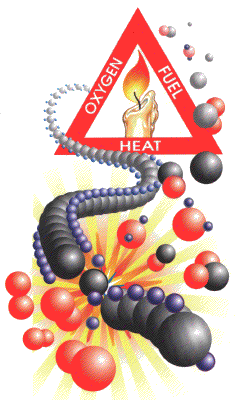- Our Commitment
- Elements of a Fire
- Building Reviews
- Fire Extinguishers
The mission of the fire safety program is to provide a proactive fire prevention program to ensure the safety of MSU-Texas students, faculty, staff, and visitors.
This mission is addressed through a comprehensive effort of fire safety education, fire and life safety inspections and oversight of all maintenance performed on fire and life safety systems installed in all campus facilities.
The Manager, Risk Management & Safety provides code interpretation, code review and ensures code compliance of all construction and renovation projects.
The State Fire Marshal's Office serves as the Authority Having Jurisdiction for MSU-Texas.

Three basic elements must be present for a fire to occur:
- Fuel -- For a fire to start there must be something to burn. The physical state of the fuel may be gases (natural gas, propane, butane, hydrogen, etc.); liquids (gasoline, kerosene, turpentine, alcohol, paint, varnish, lacquer, etc.) or solid (coal, wood, paper, cloth, grease, etc.)
- Heat -- For a fire to start there must be a source of ignition, usually heat or a spark. Heat sources include: open flame, hot surfaces, sparks and arcs, friction-chemical action, electrical energy and compression of gases
- Oxygen -- A source of oxygen is needed. Approximately 16% is required. Normal air contains 21% oxygen. Some fuels contain enough oxygen within their make-up to support burning.
These three components make up the fire triangle and proper combination of these three elements invariably results in a fire. By nature, a triangle needs three sides. Take away one of the sides, and the triangle collapses. The same is true of fire. Take away any of the three components of fire: fuel, heat or oxygen and the fire collapses, meaning that it can’t burn.
It is important to determine in advance what your response will be in the event of a fire occurrence on campus. The basic steps you will follow are:
- Step 1: Activate Alarm
- Step 2: Dial 911 (or from a cell phone Dial 940-397-4239)
- Step 3: Evacuate the Building
A Fire Safety Building Review is a proactive fire prevention program to ensure the safety of students, faculty, staff, and visitors on campus.
The Fire Safety Building Review will evaluate public areas including hallways, stairwells, conference rooms, classrooms, storage areas, and mechanical rooms. The reviewer looks for unsafe practices and conditions related to fire and life safety codes that may contribute to a fire or deter from effective evacuation of a building in case of an emergency.
Reviews are conducted on a scheduled frequency based on building’s assigned occupancy classification. A building review can be conducted by request or in response to a safety concern or complaint. In response to a written or verbal safety concern or complaint, the building will receive a Fire Safety Building Review within three business days after the receipt of the complaint.
Common concerns that are evaluated during a review are:
- Unapproved storage in hallways and stairways.
- Blocked emergency exits.
- Fire doors that are propped open or do not operate properly.
- Permanent use of extension cords.
- Non-operational exit signs and emergency lighting.
- You have been trained.
- The fire alarm has been activated and 911 called.
- The fire is small and there is very little smoke.
- You have a clear exit out of the building.
- Extinguisher is rated for materials involved in the fire.
- Pull the pin
- Aim nozzle at the base of the fire
- Squeeze the handle
- Sweep side to side
Extinguisher Locations
Fire Extinguishers can be found in every building on campus:
- Fire Extinguisher Cabinets, smaller, less-conspicuous cabinets usually located in exit corridors and can be surface mounted or recessed into the walls. This is the most common extinguisher location on campus.
- Fire Hose Cabinets, large, red metal cabinets commonly located in the walls of exit corridors. This is a common location for portable extinguishers on campus.
- Wall-mounted Brackets hold extinguishers that are not stored in cabinets. This method keeps extinguishers in plain view on the walls, and is most common in workshops, and large office suites.
If you notice a portable fire extinguisher that is missing, not in its proper place, or has been used, please report this to Facilities Services at 940-397-4032.